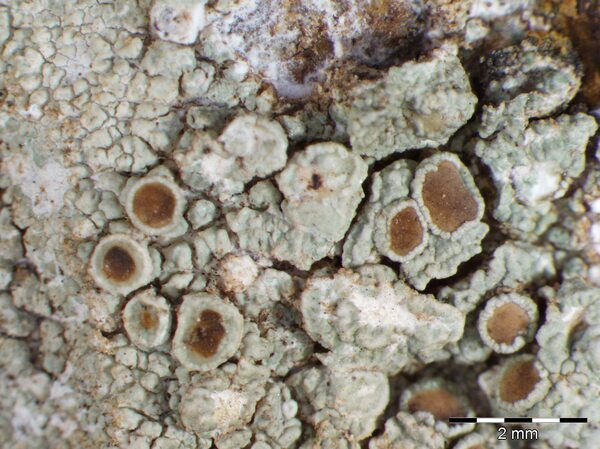Lecanora rhodi Szatala
Denkschr. Akad. Wiss. Wien, math.-naturw. Kl., 105: 38, 1943.
Synonyms:
Distribution: C - Sar (Dickhauser & al. 1995).
Description: Thallus crustose, episubstratic, rimose to verrucose-areolate, rather thick, yellowish white to cream-coloured, epruinose, without a distinct prothallus. Apothecia lecanorine, sessile and constricted at base, 0.4-2 mm across, with a reddish-orange to yellowish brown, white-pruinose, flat to strongly convex disc, and a prominent to finally excluded, smooth, entire or flexuose proper margin. Thalline exciple ecorticate, with numerous small crystals dissolving in K; proper exciple c. 20 µm wide, with numerous small crystals; epithecium grey-brown, with small crystals; hymenium colourless, 50-65 µm high; paraphyses sparingly branched, the apical cells slightly thickened; hypothecium colourless. Asci 8-spored, clavate, very thin-walled, with a K/I+ blue, tall tholus penetrated by a faintly amyloid apical cushion, the wall K/I-, surrounded by a blue outer layer, Lecanora-type. Ascospores 1-celled, hyaline, ellipsoid to broadly ellipsoid, 10-14 x 5-7.5 µm. Photobiont chlorococcoid. Spot tests: thallus K+ yellow turning red, C-, KC-, P+ orange-red. Chemistry; atranorin, norstictic acid, 2-0-methylperlatolic acid (all major), chloroatranorin, connorstictic acid and an unidentified depside (minor).Note: an apparently Mediterranean-Atlantic lichen of the L. subcarnea-group, also known from North America (LaGreca & Lumbsch 2001), found on subvertical or rain-sheltered surfaces of base-rich siliceous rocks in humid areas, at low elevations. For further details see Dickhauser & al. (1995).
Growth form: Crustose
Substrata: rocks
Photobiont: green algae other than Trentepohlia
Reproductive strategy: mainly sexual
In underhangs rarely wetted by rain
Commonnes-rarity: (info)
Alpine belt: absent
Subalpine belt: absent
Oromediterranean belt: absent
Montane belt: absent
Submediterranean belt: absent
Padanian area: absent
Humid submediterranean belt: absent
Humid mediterranean belt: extremely rare
Dry mediterranean belt: absent

Predictive model
Growth form: Crustose
Substrata: rocks
Photobiont: green algae other than Trentepohlia
Reproductive strategy: mainly sexual
In underhangs rarely wetted by rain
Commonnes-rarity: (info)
Alpine belt: absent
Subalpine belt: absent
Oromediterranean belt: absent
Montane belt: absent
Submediterranean belt: absent
Padanian area: absent
Humid submediterranean belt: absent
Humid mediterranean belt: extremely rare
Dry mediterranean belt: absent

Predictive model
 INDEX FUNGORUM
INDEX FUNGORUM
 GBIF
GBIF


